Upgrading your surround sound can enhance your audio experience. In-ceiling and in-wall speakers are both options to consider. They allow you to have surround sound in one room or multiple rooms. However, you may wonder which one gives you more value for your money. we are going to compare In-Ceiling vs In-Wall Speakers and give the cons and pros of each one in this article.
In-ceiling speakers are a more affordable option and can be installed on any ceiling. They are also compact. In-wall speakers are larger and more powerful, but they are more expensive. They can be placed on any wall.
When deciding between the two, it’s important to consider their differences, benefits, and how they should be used. You should also think about the aesthetics of the two and your space and budget.
About In-ceiling speaker size, we have a detailed guide: Here
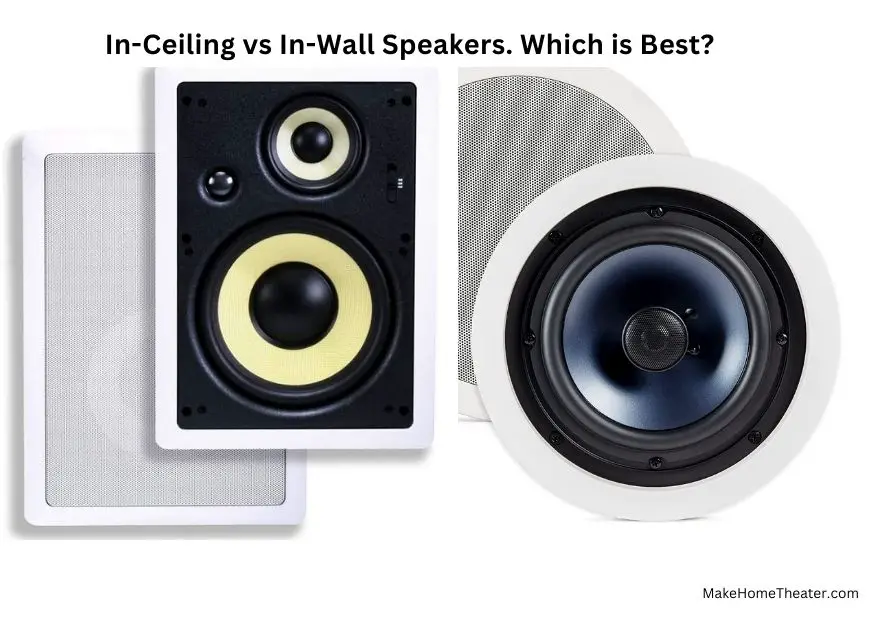
Table of Contents
In-Ceiling Speakers Pros And Cons
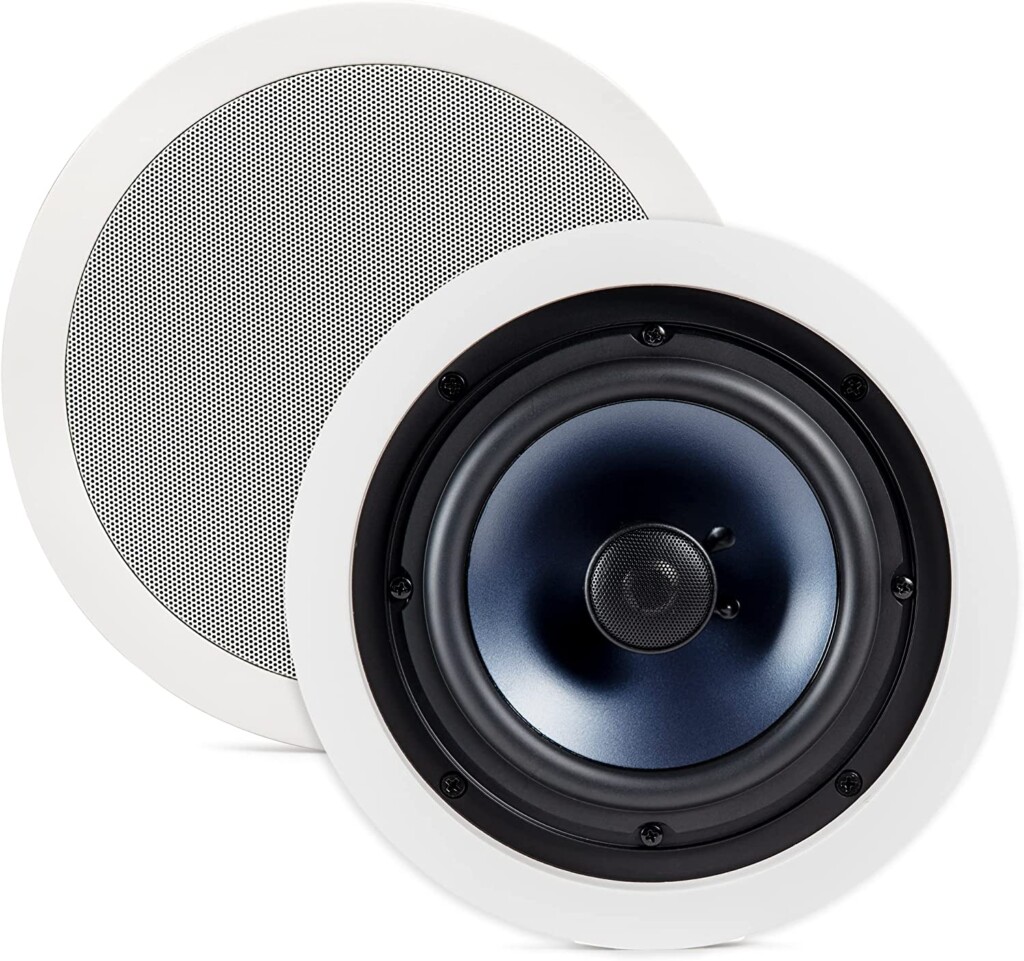
In-ceiling speakers are circular and designed to fit in your ceiling. They are out of sight and provide an extra dimension of sound. These speakers are downward-firing and can be purchased individually or in a set. Individual in-ceiling speakers are usually around $40-50 and offer good quality.
These speakers can be used in one room or multiple rooms. They can create a continuous, surround sound experience in many rooms, such as background music at a party. They offer a flexible and subtle sound experience for indoor or outdoor entertaining.
In-Ceiling Speakers Pros
In-ceiling speakers won’t ruin the style of your room, and they can even be installed on the wall if desired. These speakers provide an extra dimension to your sound and are out of sight. They are also budget-friendly.
If you have more specific questions about in-ceiling speakers and how they work, you can check out other articles on whether they need a backbox, an amp, or any safety concerns with insulation.
More Attractive
In-ceiling speakers can blend in with the style of your theater room, living area, or outdoor entertainment space. They won’t distract from a clean, sophisticated look.
These speakers are often not noticeable and simply blend in with the look and feel of your space. They are an aesthetically pleasing option.
Immersive Audio Experience
In-ceiling speakers can improve the overall sound in your space. They create a more room-filling sound and add height to your sound system, whether it’s a soundbase, soundbar, or traditional surround sound setup with a receiver. These speakers can help bring movie theater-like sound to your home and provide an immersive listening experience.
Hidden From Sight
In-ceiling speakers are a great addition to your sound system because they add dimension and are out of sight. The ceiling is a good location for speakers because they are meant to be heard, not seen. In-ceiling speakers are smaller and more compact than in-wall speakers, which makes them less noticeable. This can be a desirable feature.
Cost-Effective
In-ceiling speakers are an affordable option for expanding your sound system. They cost around $40-50 per speaker, and sets of five are usually around $150. This makes it possible to add as many in-ceiling speakers as your budget allows and arrange them as desired.
In-Ceiling Speakers Cons
There are a few drawbacks to using in-ceiling speakers. They may have a narrower sound compared to other options, they may not have as much technology, and you may need to purchase several of them or a package to get the desired effect. However, these factors may not be a concern for everyone.
Limited Soundstage
In-ceiling speakers are smaller than in-wall speakers, with a size of typically 6.5 inches (but they can be up to 8 inches). This smaller size means they have a narrower sound field compared to larger in-wall speakers. Whether this is a drawback depends on your needs.
Less Technology
Due to their small size, in-ceiling speakers can only fit a limited amount of technology into the speaker enclosure. They may not have as much technology as larger in-wall speakers and may be better suited for easy listening rather than high-powered sound. This is something to consider when choosing between in-ceiling and in-wall speakers.
The Need to Buy More
It is often recommended to purchase several in-ceiling speakers because they are smaller and have a narrower sound field. While they can be bought in a set, a set is usually the same price as a single high-quality in-wall speaker. Additionally, installing more speakers means more work with hole cutting, wiring, and other tasks. This is something to consider when deciding between in-ceiling and in-wall speakers.
In-Wall Speakers Pros And Cons
In-wall speakers are rectangular and installed in the walls. They can serve as left and right channels, additional front, and rear speakers, or continuous sound in multiple rooms. These speakers are larger than in-ceiling speakers, with the most common size being 8 inches. They are horizontal-firing, which allows the sound to travel across the room rather than down from the ceiling like in-ceiling speakers.
In-wall speakers have the tweeter placed beside the bass driver(s) instead of in front of it like in-ceiling speakers. Information about backboxes, amps, and managing the speakers around insulation also applies to in-wall speakers.
In-Wall Speakers Pros
In-wall speakers offer good sound quality, placement flexibility, and a larger sound stage. They can be a useful addition to any home entertainment system.
Sound Quality
Because they are larger, in-wall speakers have more space for extra sound technology and features. As a result, they are often more powerful and higher quality than in-ceiling speakers. In-wall speakers can add multiple dimensions of sound when placed in different walls of a room or other area, rather than just providing downward-firing sound like in-ceiling speakers.
Multi-Purpose Placement
In-wall speakers can be placed on any wall, high or low, in the front, back, or sides of the room. They can provide sound throughout a house when placed on walls throughout the home. There are also options for outdoor use, but it’s important to look for speakers that are specifically rated for outdoor use if you plan to use them outside.
Wide Sound Field
In-wall speakers can provide sound throughout a large space and help connect multiple rooms. They are good for entertaining and can be placed in the main living area, kitchen, and dining room for a cohesive sound experience.
In-Wall Speakers Cons
In-wall speakers are flexible in placement and can produce a powerful, broad sound in your space. However, they are usually more expensive and larger in size compared to in-ceiling speakers. This is something to consider when deciding which type of speaker is best for you.
Higher-Priced
Single in-wall speakers can be found on sale online and in stores for $40-150+. While they are still budget-friendly in some cases, they are generally more expensive than individual in-ceiling speakers. The extra cost may be worth it for some people, but it may not fit into everyone’s budget.
Larger In Size
In-wall speakers are larger, typically 8 inches, while most in-ceiling speakers are 6.5 inches. Because of their size, placement is important. You don’t want them to be too noticeable and take away from the look of your space. This can be difficult in smaller rooms.
Can You Interchange In-Ceiling And In-Wall Speakers?
In some cases, you can use in-ceiling and in-wall speakers interchangeably. The holes and shapes will be different during installation, but the overall sound of the two is similar when they are switched. If you have in-ceiling speakers and want to use them as in-wall speakers, or vice versa, the sound quality may not be significantly different.
If you’re trying to be cost-effective by mixing and matching, keep in mind that the quality you pay for may vary. For example, Monoprice 3-Way Fiber In-Wall Speakers may be cheaper than Sonos Architectural in-wall speakers, but the quality may not be the same. It’s important to consider your overall quality needs while trying to save money.
In-Ceiling And In-Wall Speakers – Which Is Better?
The choice between in-ceiling and in-wall speakers depends on your needs and budget. Both have pros and cons and serve different purposes. If you want to add another dimension to your sound system at a low cost, in-ceiling speakers are a good option. They are flexible, compact, and provide added sound.
If you want a powerful, multi-dimensional sound at a higher cost, in-wall speakers are a good choice. They have a large size and provide a great sound for a large area, with some flexibility in placement. You can be creative in how you “hide” them or make them less noticeable.
In some cases, you can use in-ceiling and in-wall speakers interchangeably. If you change your mind, you can try moving the original speakers before making a new purchase.
In-Ceiling And In-Wall Speakers Q&A
What are in-ceiling speakers?
In-ceiling speakers are speakers that are installed in the ceiling. They are typically circular in shape and designed to fit into the ceiling. They are downward-firing and can be used in one room or multiple rooms to create a surround sound experience.
What are in-wall speakers?
In-wall speakers are rectangular-shaped speakers that are installed on the inside of walls. They can serve as left and right speaker channels, additional front and rear speakers, or as continuous sound throughout multiple rooms. They are horizontal-firing and are typically larger than in-ceiling speakers.
How do in-ceiling speakers work?
In-ceiling speakers work by sending sound waves downward towards the listener. They are typically installed in the ceiling and are connected to a sound system, such as a receiver or amplifier. They can be used to create a surround sound experience in a single room or multiple rooms.
How do in-wall speakers work?
In-wall speakers work by sending sound waves horizontally towards the listener. They are installed in the walls and are connected to a sound system, such as a receiver or amplifier. They can serve as left and right speaker channels, additional front and rear speakers, or as continuous sound throughout multiple rooms.
What are the differences between in-ceiling and in-wall speakers?
There are several differences between in-ceiling and in-wall speakers, including size, shape, and direction of the sound. In-ceiling speakers are typically circular and smaller in size, while in-wall speakers are rectangular and larger. In-ceiling speakers are downward-firing, while in-wall speakers are horizontal-firing. In-ceiling speakers can be used in one room or multiple rooms to create a surround sound experience, while in-wall speakers can be used to create multiple dimensions of sound when placed in several walls of a room or other area. In-ceiling speakers are also generally more budget-friendly than in-wall speakers.
What are the pros and cons of in-ceiling speakers?
Some pros of in-ceiling speakers include their compact size, budget-friendliness, and ability to add another dimension to the sound in a room. They can be used in one room or multiple rooms and are aesthetically pleasing since they blend in with the ceiling. However, some cons of in-ceiling speakers include a narrower sound field, less technology, and the need to purchase several of them or a package to make a significant impact on sound.
The pros and cons of in-wall speakers?
Some pros of in-wall speakers include their flexibility in placement, large size, and powerful, multi-dimensional sound. They can be used in multiple rooms and can add multiple dimensions of sound when placed in several walls of a room or other area. However, some cons of in-wall speakers include their higher cost and bulkier size, which can limit placement options and make them more noticeable in a room.
Can in-ceiling speakers be used outdoors?
In-ceiling speakers are not typically designed for outdoor use and may not be able to withstand outdoor conditions such as moisture and extreme temperatures. If you want to use speakers outdoors, it is best to look for speakers that are specifically designed for outdoor use.
Can in-wall speakers be used outdoors?
In-wall speakers are not typically designed for outdoor use and may not be able to withstand outdoor conditions such as moisture and extreme temperatures. However, there are some in-wall speakers on the market that are specifically designed for outdoor use. If you want to use in-wall speakers outdoors, it is best to look for speakers that are specifically rated for outdoor use.
How much do in-ceiling speakers cost?
The cost of in-ceiling speakers can vary depending on the brand and features. Individual in-ceiling speakers can range in price from around $40-50 per speaker for a good quality speaker product. Sets of in-ceiling speakers can range in price from around $150-300 or more, depending on the number of speakers in the set and the quality.
How much do in-wall speakers cost?
The cost of in-wall speakers can vary depending on the brand and features. Single in-wall speakers can range in price from around $40-150+ for a good quality speaker product. Sets of in-wall speakers can range in price from around $200-500 or more, depending on the number of speakers in the set and the quality. In-wall speakers are generally more expensive than in-ceiling speakers.
Are in-ceiling speakers or in-wall speakers better for sound quality?
Both in-ceiling and in-wall speakers can provide good sound quality, but in-wall speakers tend to be higher quality due to their larger size and ability to fit more technology into the speaker enclosure. In-wall speakers can provide a more powerful, multi-dimensional sound than in-ceiling speakers.
Are in-ceiling speakers or in-wall speakers more flexible in placement?
Both in-ceiling and in-wall speakers have some flexibility in placement, but in-wall speakers are generally more flexible due to their larger size and ability to be placed on any wall in a room. In-ceiling speakers are limited to the ceiling and may not be suitable for all rooms or locations.
Do in-ceiling speakers or in-wall speakers more aesthetically pleasing?
This is subjective and depends on personal preference. Some people may prefer the sleek, unobtrusive look of in-ceiling speakers, while others may prefer the flexibility and larger size of in-wall speakers.
Can in-ceiling speakers be used as in-wall speakers?
In many cases, in-ceiling speakers can be used as in-wall speakers and vice versa. While the hole sizes and shapes will be different during installation, the overall sound of the two is similar in their flipped locations. However, it is important to note that you may not get the same quality as you would with a speaker specifically designed for the intended location.
Can in-wall speakers be used as in-ceiling speakers?
In many cases, in-wall speakers can be used as in-ceiling speakers and vice versa. While the hole sizes and shapes will be different during installation, the overall sound of the two is similar in their flipped locations. However, it is important to note that you may not get the same quality as you would with a speaker specifically designed for the intended location.
What should I consider when deciding between in-ceiling and in-wall speakers?
When deciding between in-ceiling and in-wall speakers, you should consider your budget, the size and layout of your space, your desired sound quality and power, and your personal aesthetic preferences. You should also consider the ease of installation and any additional equipment or accessories that may be required for each type of speaker.
Can in-ceiling and in-wall speakers be used together in the same sound system?
Yes, in-ceiling and in-wall speakers can be used together in the same sound system. This can allow you to create a multi-dimensional sound experience using both types of speakers in different locations.
Are in-ceiling and in-wall speakers compatible with all sound systems?
In-ceiling and in-wall speakers are generally compatible with most sound systems, including receivers, amplifiers, soundbars,
How do I install in-ceiling or in-wall speakers?
Installation of in-ceiling and in-wall speakers involves cutting holes in your walls or ceiling, running wires to the speakers, and connecting the speakers to your sound system. It is important to follow the manufacturer’s instructions and any local building codes when installing speakers.
If you are not comfortable with electrical work or cutting holes in your walls or ceiling, it is recommended to hire a professional for installation.


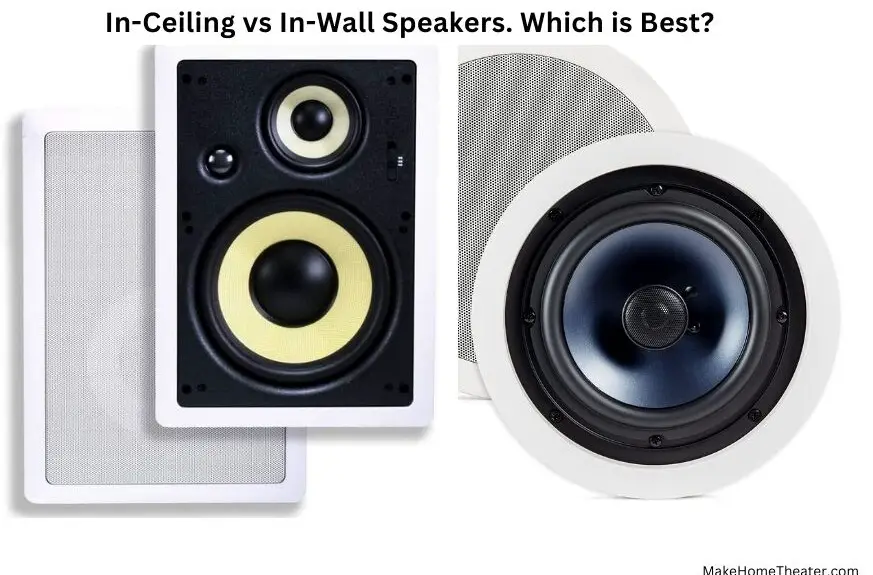
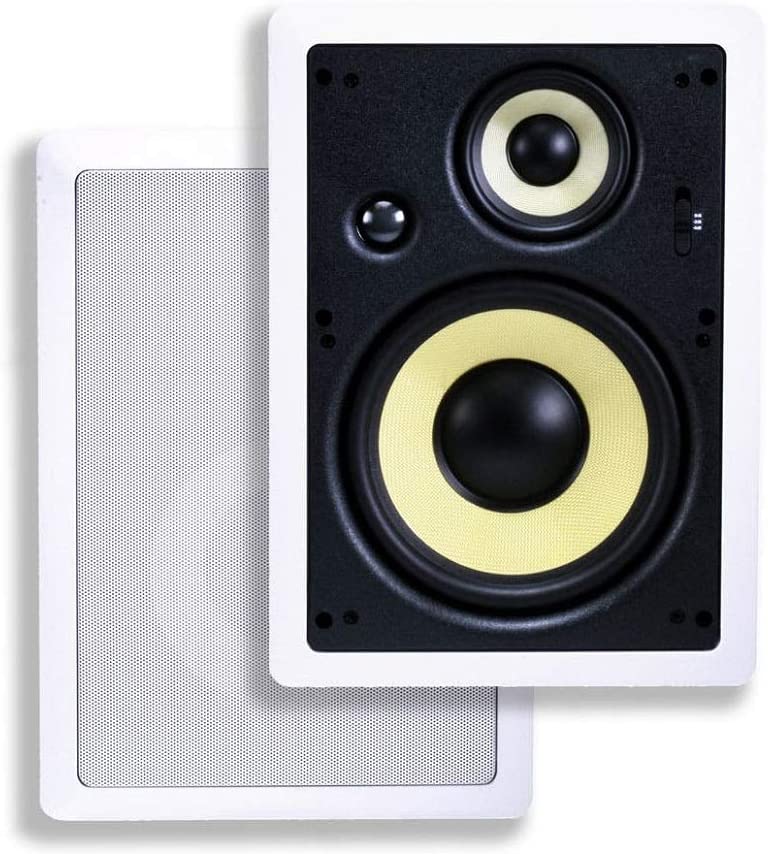
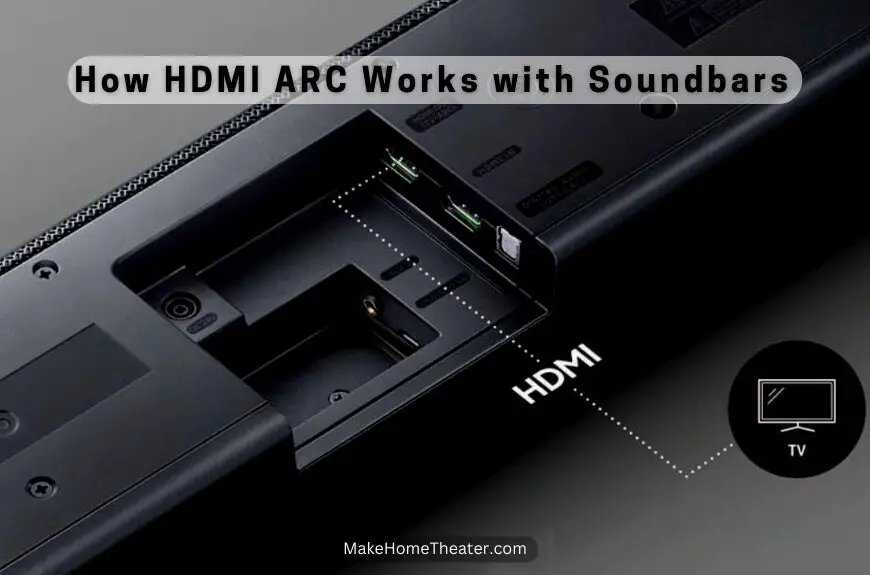






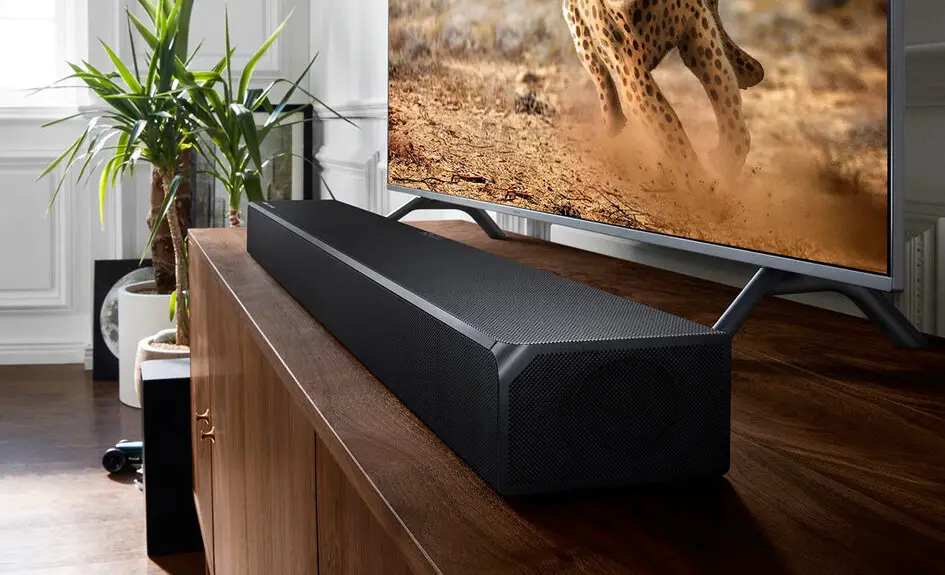


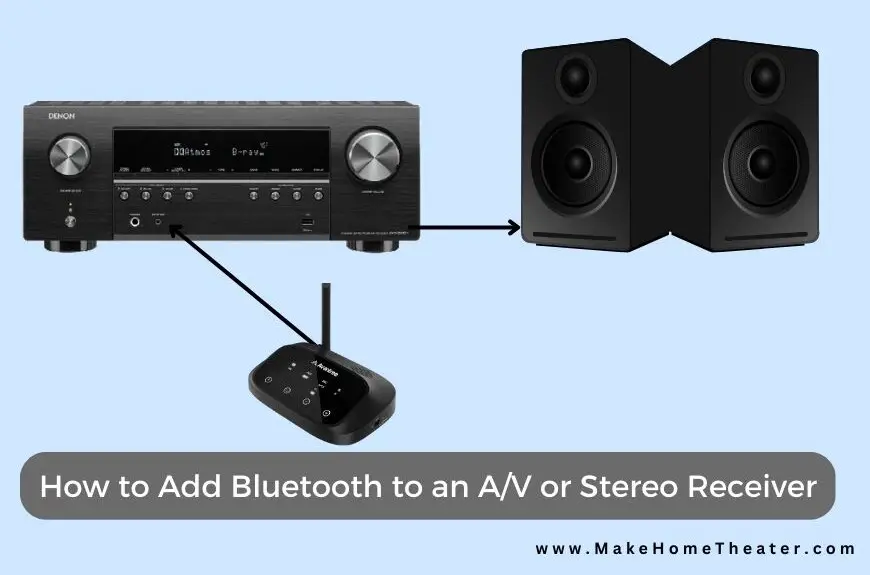
1 Comment